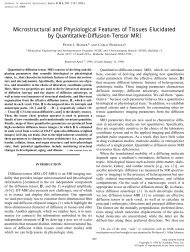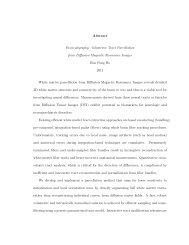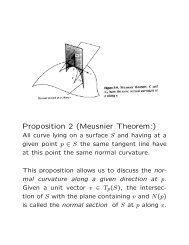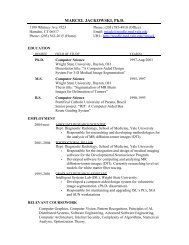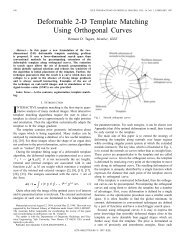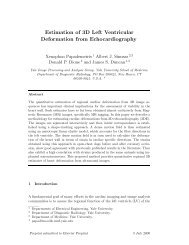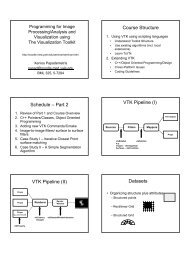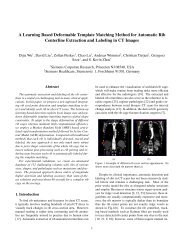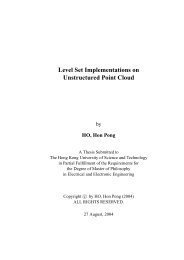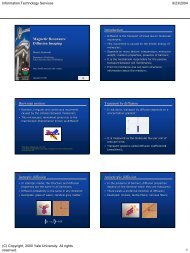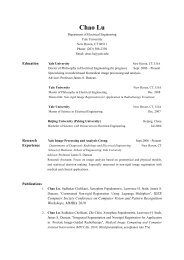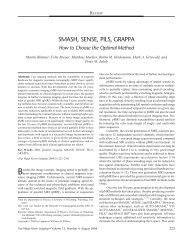Pulsed-field gradient nuclear magnetic resonance as a tool for ...
Pulsed-field gradient nuclear magnetic resonance as a tool for ...
Pulsed-field gradient nuclear magnetic resonance as a tool for ...
You also want an ePaper? Increase the reach of your titles
YUMPU automatically turns print PDFs into web optimized ePapers that Google loves.
326<br />
PRICE<br />
D will affect the me<strong>as</strong>ured echo attenuation<br />
Ž 114, 116 . .<br />
The situation with anisotropic restricted diffusion<br />
is more complicated, and we will illustrate<br />
this with reference to diffusion in a cylinder with<br />
an arbitrary Ž polar. angle, , between the symme-<br />
try axis of the cylinder and the static <strong>magnetic</strong><br />
<strong>field</strong> Ž which is also the direction of the <strong>gradient</strong>.<br />
Ž Fig. 9 . . Such a cylinder can be thought of, <strong>for</strong><br />
example, <strong>as</strong> a simplistic model of a muscle-fiber<br />
cell. The SGP solution <strong>for</strong> this geometry is given<br />
by Ž 117 .<br />
2 4 2 n<br />
2<br />
nm km<br />
2K R Ž 2qR. sin Ž 2. 1 Ž 1. cosŽ 2 qL cos . <br />
EŽ q,. Ý Ý Ý 2 2 2 2 2<br />
L nRL 2qR cos 2qR sin m<br />
n0 k1 m0<br />
2 Ž . Ž . 2 2 Ž . 2 Ž 2 2.<br />
km km<br />
2 n 2<br />
<br />
2<br />
km<br />
m ½ ž R / ž L / 5<br />
J Ž 2qR sin . exp D 110 where L is the length of the cylinder, R is the<br />
radius of the cylinder, and km is the kth nonzero<br />
<br />
root of the equation J Ž . m km 0, where J is the<br />
Bessel function of the first kind, and the constant<br />
K nm depends on the values of the indexes n and<br />
m according to<br />
K nm 1 if nm0<br />
Knm 1 if nm0orm0and n 0<br />
Knm 1 if n, m0. 111 Now, the mathematical complexity is no concern<br />
to us here and the point that we wish to emph<strong>as</strong>ize<br />
is the dependence; thus, in contradistinction<br />
to the c<strong>as</strong>es of free diffusion and diffusion<br />
with a sphere, in an anisotropic system the spinecho<br />
attenuation is now a function of the direction<br />
of the <strong>gradient</strong>. In fact, if we had a less<br />
symmetric geometry Ž e.g., an elliptic cylinder . ,<br />
then the equation <strong>for</strong> Eq, Ž . should also be<br />
dependent on the azimuthal angle, . If we set<br />
0, then the solution given by Eq. 110 reduces,<br />
<strong>as</strong> expected, to the solution <strong>for</strong> diffusion<br />
between planes Ži.e., Eq. 92 and noting that<br />
L2R . . Similarly, if 2, Eq. 110 reduces<br />
to the solution <strong>for</strong> diffusion in a cylinder Ž 110 . ,<br />
EŽ q,.<br />
<br />
2<br />
22qR Ž . Ý Ý<br />
k1 m0<br />
2 <br />
2 2<br />
K J Ž 2qR. exp Ž R. 0m km m km D4<br />
2 2<br />
2 2 2<br />
km km<br />
Ž 2qR. Ž m .<br />
.<br />
<br />
112<br />
The echo-attenuation curves <strong>for</strong> diffusion in a<br />
cylinder versus are plotted <strong>for</strong> three different<br />
values of in Fig. 10. The long time limiting<br />
<strong>for</strong>mula <strong>for</strong> the cylinder is given by Ž 117 .<br />
Ž .<br />
E q,<br />
2 8R 1cosŽ 2 qL cos .J Ž 2 qR sin .<br />
1<br />
.<br />
4 2<br />
2<br />
Ž 2qR. L Ž cos sin .<br />
113 When 0, this, of course, reduces to the long<br />
time <strong>for</strong> diffusion between planes <strong>as</strong> given in Eq.<br />
93 Ž n.b. L 2 R . , and when 2, this reduces<br />
to Ž 117 .<br />
2J Ž 2qR.<br />
1<br />
EŽ q,. . 114 2<br />
Ž 2qR.<br />
The echo-attenuation curves <strong>for</strong> diffusion in a<br />
cylinder versus qR are plotted <strong>for</strong> three different<br />
values of in Fig. 11.<br />
Clearly, the dependence on the attenuation<br />
curves and the diffraction patternsor alternately,<br />
we can think of this <strong>as</strong> the orientation of<br />
D with respect to the <strong>gradient</strong>provides an additional<br />
structural probe. If the restricted diffusion<br />
effects are not accounted <strong>for</strong> and free diffusion is<br />
<strong>as</strong>sumed, and Eq. 104 ,<br />
which is valid only <strong>for</strong><br />
free diffusion, is used to analyze the attenuation<br />
data, then D is really an apparent diffusion ten-<br />
2<br />
2



